It looks like you're using an Ad Blocker.
Please white-list or disable AboveTopSecret.com in your ad-blocking tool.
Thank you.
Some features of ATS will be disabled while you continue to use an ad-blocker.
share:
This is a stone that I've had now for about 20 years. I've tried many times through amateur opinion, to identify what it could be. Do to the story
of how my brother found it, we have always assumed meteorite. The problem is that it doesn't look like most meteorites I have compared. Recently I
started looking at lunar meteorites and noticed some similarities. The only one closest to the main composition of mine, would be the
Kalahari. Though looking at the other
examples, I noticed that the embedded matter in my rock, similarly
matched most lunar examples. Some of the deposits seem to be feldspar in a crystallized gray soft material. Some feldspar areas are fused in hard
light brown stone. Two different colors of basalts appear on my rock and some deposits are closer to being tektite. Learning that lunites have fusion
crusts that are highly vesicular, also points me towards thinking my rock is one.
Picture of front (Bic lighter is one inch wide)

Back
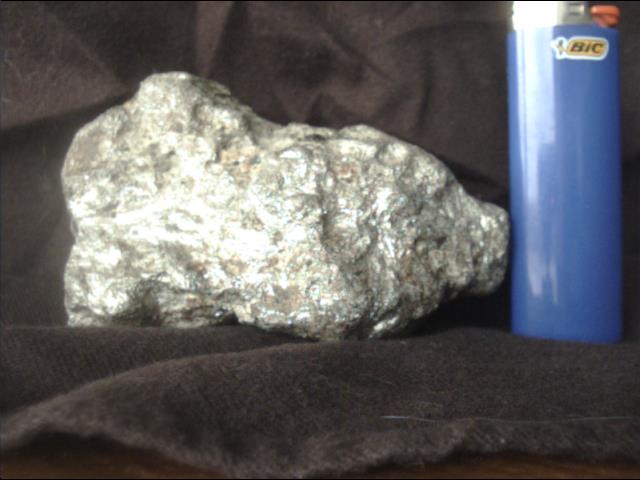
Bottom
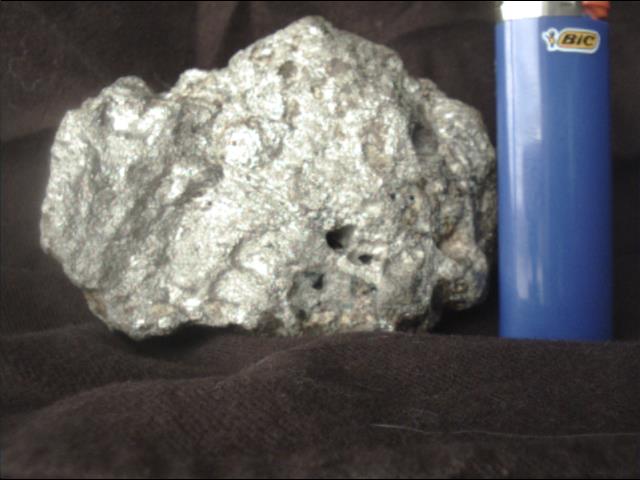
Top
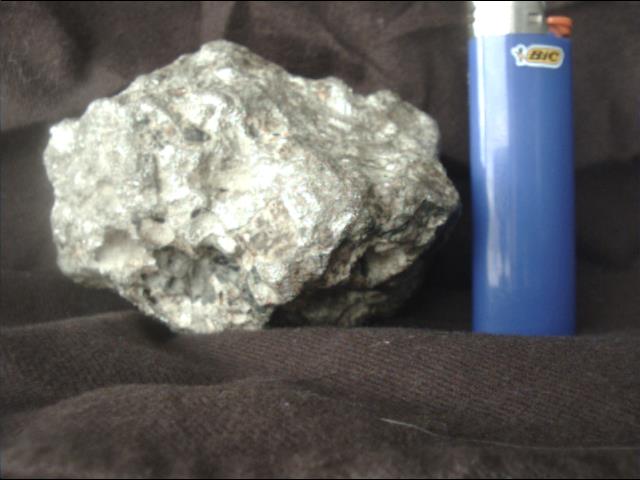
Example of two colors of basalt (grayish glass color and obsidian color)
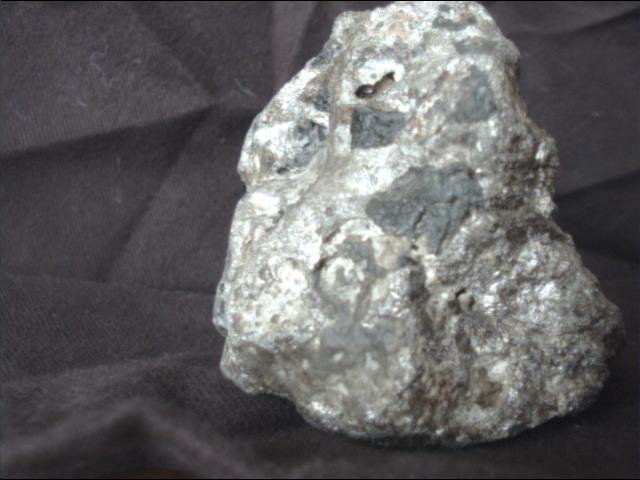
Example of feldspar

The rock in general is nearly all a pale, reflective silver color. This is mainly due to what I may never live down, if it turns out to be a lunar meteorite. When I was ten years old, I took it to my geology class. My teacher had no clue what it was, did some acid tests, hardness tests and magnetivity tests. Since it was part of my grade to present it. I had it sand blasted to clean it up. If this is indeed the first lunar meteorite found in North America, I sincerely apologize to the scientific community for being a child.
The rock weighs a little more than a kilogram, was found in northeast Ohio. The exact location, is unknown due to the death of my brother. I hope that the rock experts here, can help me determine its true identification. The pictures are low grade, due to only having a web cam.
Picture of front (Bic lighter is one inch wide)

Back

Bottom

Top

Example of two colors of basalt (grayish glass color and obsidian color)

Example of feldspar

The rock in general is nearly all a pale, reflective silver color. This is mainly due to what I may never live down, if it turns out to be a lunar meteorite. When I was ten years old, I took it to my geology class. My teacher had no clue what it was, did some acid tests, hardness tests and magnetivity tests. Since it was part of my grade to present it. I had it sand blasted to clean it up. If this is indeed the first lunar meteorite found in North America, I sincerely apologize to the scientific community for being a child.
The rock weighs a little more than a kilogram, was found in northeast Ohio. The exact location, is unknown due to the death of my brother. I hope that the rock experts here, can help me determine its true identification. The pictures are low grade, due to only having a web cam.
Starred and Flagged. This response is mostly just to bump the topic, as I am no expert on this. Will be watching closely to see if anyone can figure
it out.
reply to post by blindprometheus
Being no expert myself, I'll simply say, in my pretend American rural accent:
"Looky-like we got gold up on 'em dare hills."
Being no expert myself, I'll simply say, in my pretend American rural accent:
"Looky-like we got gold up on 'em dare hills."
Shouldn't it be black from the inbound trip?
No expert here....Just the ones I have seen are burnt.
No expert here....Just the ones I have seen are burnt.
edit on 26-12-2013 by whyamIhere because: (no reason given)
reply to post by Zcustosmorum
Guess they are rare and wanted.
Guess they are rare and wanted.
Meteorites, including lunar and martian meteorites, are easily available for purchase on the Internet. Samples (end cuts, slices, chips, crumbs, dust) of the lunar meteorites sell on the Internet (e.g., e-Bay) for between about $800 and $40,000 per gram, depending upon rarity (perceived or real!) and demand. By comparison, the price of 24-carat gold is about $60 per gram and gem-quality diamonds start at $1000-2000/gram.
reply to post by whyamIhere
I'm unsure myself. When a real expert comes in, I'm sure I'll be corrected on my labeling of feldspar and basalts. As far as turning black, it was mostly a earthy color before it was sand blasted.
I'm unsure myself. When a real expert comes in, I'm sure I'll be corrected on my labeling of feldspar and basalts. As far as turning black, it was mostly a earthy color before it was sand blasted.
Hell, if that's a lunar meteorite then I have tons of them around my house.
I had a rock that I was hanging onto for a few years and convinced myself it was a meteorite. I was working in Boston at the time and had a job in
Cambridge. So I called Harvard University and made an appointment with their Museum of Natural History. The man in charge asked if I found it near
the ocean. I couldn't remember where I found it, but I told him I probably found it on a beach in Maine. He told me it was most likely from an old
ship used for ballast. At least I can say I went to Harvard and got an education!
Not a meteorite, Sorry.
Looks to be :
Conglomerate - Sedimentary Rock
Conglomerate forms in a very energetic environment, where rocks are eroded and carried downhill so swiftly that they aren't fully broken down into sand.
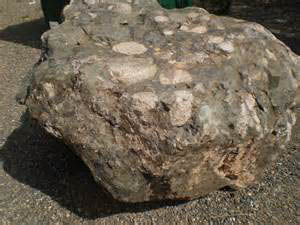
Looks to be :
Conglomerate - Sedimentary Rock
Conglomerate forms in a very energetic environment, where rocks are eroded and carried downhill so swiftly that they aren't fully broken down into sand.

reply to post by RocksFromSpace
I looked at the Internets examples of Conglomerate stones. Could not find any that where high in metal content. I can't say its not a conglomerate stone but my area also has very gentle hills and flat land.
I looked at the Internets examples of Conglomerate stones. Could not find any that where high in metal content. I can't say its not a conglomerate stone but my area also has very gentle hills and flat land.
reply to post by Zcustosmorum
Umm he's from Ohio. That's pretty much all city not too rural. Their accent is more eastern than anything else.
Umm he's from Ohio. That's pretty much all city not too rural. Their accent is more eastern than anything else.
I saw a moon rock in the Smithsonian in Washington and though it was flatter it looked similar to this.
I know how the rock in the Smithsonian got here but how did yours. I've never heard of a lunar meteorite. Did a piece of the moon break off? Was it
hit by something large that broke part of it off?
reply to post by AutumnWitch657
This will answer your question more than I could. To me it looks just like the one of a kind find Kalahari 009, found in Botswana. I'll have to look to find the Smithsonian example you wrote of. The Kalahari has the same metallic look.
This will answer your question more than I could. To me it looks just like the one of a kind find Kalahari 009, found in Botswana. I'll have to look to find the Smithsonian example you wrote of. The Kalahari has the same metallic look.
reply to post by blindprometheus
You need to talk to miners. Seen this rock before in Colorado.
The Bot
You need to talk to miners. Seen this rock before in Colorado.
The Bot
You can send a pic to Scott Wolter from America Unearthed....can't hurt
reply to post by dlbott
Slag ore from various mining operations in the past, is a very plausible source. Can't rule it out.
Slag ore from various mining operations in the past, is a very plausible source. Can't rule it out.
reply to post by ujustneverknow
That is the kind of reply I was hoping for. Thank you, I'll look up Scott Wolter. I really couldn't find a good verification process. That is why I'm posting here.
That is the kind of reply I was hoping for. Thank you, I'll look up Scott Wolter. I really couldn't find a good verification process. That is why I'm posting here.
reply to post by blindprometheus
Here's a simple test;
1. Take the toilet tank cover off and turn it upside down so the unglazed area is showing
2. Take the rock and scratch it across the unglazed tile
What color line did it leave?
Below are the most commonly mistaken rocks for meteorites
Red = Hematite
Brown = Limonite
Black = Magnetite
Meteorites will leave NONE to a very Faint color line
Here's a simple test;
1. Take the toilet tank cover off and turn it upside down so the unglazed area is showing
2. Take the rock and scratch it across the unglazed tile
What color line did it leave?
Below are the most commonly mistaken rocks for meteorites
Red = Hematite
Brown = Limonite
Black = Magnetite
Meteorites will leave NONE to a very Faint color line
reply to post by RocksFromSpace
It left a light black line. Thanks. Very simple test, very simple answer, magnetite.
Example. It does look like my rock.
It left a light black line. Thanks. Very simple test, very simple answer, magnetite.
Example. It does look like my rock.
edit on
193Thursday381226-06:00Thu, 26 Dec 2013 21:38:22 -0600201312America/Chicago by blindprometheus because: (no reason given)
new topics
-
New Disney Star Wars Films Failing Test of Time?
Movies: 10 hours ago
top topics
-
Mass UAP events. DC. Machester Airport, UFOs over sub base in CT, Nuke bases.
Aliens and UFOs: 17 hours ago, 16 flags -
population madness
New World Order: 16 hours ago, 5 flags -
New Disney Star Wars Films Failing Test of Time?
Movies: 10 hours ago, 5 flags -
The Cost of True Discipleship—Count the Cost
Religion, Faith, And Theology: 15 hours ago, 1 flags
active topics
-
New Disney Star Wars Films Failing Test of Time?
Movies • 16 • : Tolkien -
The Cost of True Discipleship—Count the Cost
Religion, Faith, And Theology • 5 • : alwaysbeenhere2 -
Unidentified Flying Objects Over U.S. Military Bases in Northeast UK, as of roughly 11 a.m. CST.
Aliens and UFOs • 30 • : BasicResearchMethods -
-@TH3WH17ERABB17- -Q- ---TIME TO SHOW THE WORLD--- -Part- --44--
Dissecting Disinformation • 3415 • : AianawaQ1320 -
Mass UAP events. DC. Machester Airport, UFOs over sub base in CT, Nuke bases.
Aliens and UFOs • 24 • : devilhunter69 -
Are there any good shows
Television • 69 • : Coelacanth55 -
Anyone like the Scorpions?
Music • 22 • : texas thinker -
WATCH LIVE: US Congress hearing on UFOs, unidentified anomalous phenomena
Aliens and UFOs • 153 • : vance2 -
Results of the use of the Oreshnik missile system in Dnepropetrovsk
World War Three • 262 • : Oldcarpy2 -
Trump Presidential Transition Team will not use GSA or Government entities to come to DC
US Political Madness • 21 • : matafuchs
